The air is cool, but there is a hint of Spring to it. The sky is overcast, but the expected rain holds off. A dozen volunteers gather around Hoyt Arboretum Plant Taxonomist and Herbarium Curator Mandy Tu on a gray Monday morning.
Best Tree Forever!
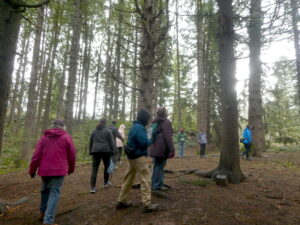
Most of the volunteers present are there for Nature Educator training, so for part of the hike, Mandy talks about “BTFs” — Best Tree Forevers as part of the Hoyt Arboretum Field Trip curriculum for 2nd through 5th graders.
These BTFs include the bigleaf maple, western redcedar, Douglas-fir, and western hemlock— four common trees native to our area.
Mandy is an Encyclopedia of Information
The group soaks up as much as they can. Bigleaf maples have the largest leaves of any maple in the world. Douglas-fir cones have little bracts that look like the legs and tail of a mouse. Western hemlock’s species epithet, heterophylla, describes how its needles have different sizes. Western redcedar’s flat needles have a butterfly pattern on the underside. Mandy shares many details about each tree, how to identify it, its ethnobotany, and other cool facts.
Mandy tells the group about lenticels, the gas-exchanging pores on the stems of some plants. A short twig is passed along so everyone gets a chance to feel the raised bumps.
MADCap Horse
There is a discussion about “MADCap Horse” — a mnemonic for remembering the most common flowering plants with opposite leaves and branches:
- MAD: maple, ash, dogwood
- Cap: for the old Caprifoliaceae family (which used to include viburnum, elderberry, and honeysuckles)
- Horse: horse chestnut and buckeyes
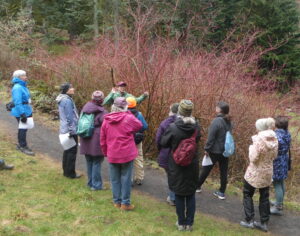
Where Are the Spring Blooms?
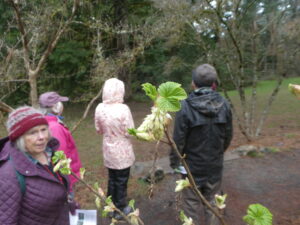
But trees are not the sole focus of the volunteer training hike. With spring in the air, we are all eager to see the wildflowers bloom.
Down in the valley near sea level, flowers are starting to burst out all over. But Hoyt Arboretum stands some 800 feet above downtown, so spring is a little slower to come along.
There are big fat buds galore on the branches, but the flowers aren’t quite out yet. A magnifier is needed to see the only new flower that we encounter – teeny tiny red female hazelnut flowers (showing their bright-red stigmas), amongst lots of male hazelnut flowers in hanging catkins. Red-flowering currant and osoberry flowers are just about open. Trillium leaves are poking above the forest floor, but most flowers have not bloomed (as of March 23, we have at least one flower now!).
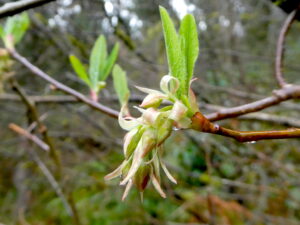
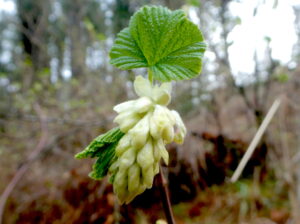
Things seem a little slow to bloom this year after our late cold winter, but the next few weeks should prove to be an explosion of color as flowers start coming out. Things change quickly, so be sure to visit often to catch all of the spring blooms.
The Land of Educational Opportunity!
One benefit of volunteering at Hoyt Arboretum are the ongoing learning opportunities. Currently, these include Plant Walk & Talks like this one with Mandy, monthly Lunch & Learn potlucks, and more. There are many public classes and tours, but even more learning opportunities exist for volunteers and members, so consider giving back to the Arboretum by volunteering or becoming a member.
 About the author:
About the author:
Greg Hill is a writer and naturalist with decades of visitor experience. An avid hiker, he spent 10 years as a Northwest Mountaineer and Trail Guide. Greg volunteered for a year at the Visitor Center before becoming a Visitor Information Specialist for HAF.
